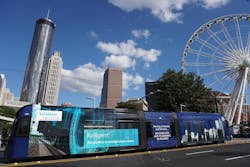Atlanta BeltLine: Community Development Through Infrastructure
The Atlanta BeltLine is working to enhance the vison of transit in the city. The idea behind the BeltLine is to transform the city of Atlanta into a more livable development.
Atlanta BeltLine Inc. is the entity overseeing the planning and execution of the Atlanta BeltLine. The ABI staff works closely with city of Atlanta departments to define details of the plan, secure funding, and ensure that members of the community are informed about each step of the project. The ABI also serves as the project management office for the construction of trails, parks and other key components that will be included in the transit line.
According to ABI the Atlanta BeltLine is the most comprehensive transportation and economic development effort undertaken in the city of Atlanta and among the largest, most wide-ranging urban redevelopment programs currently underway in the United States.
“It is in a loop of four railroad corridors. They were built by different contractors as a way to bypass Atlanta, which was so full of freight. These bypasses were built to get freight around Atlanta… they were built by four different operators over time,” said Heather Hussey-Coker, special projects manager for ABI.
The old railroad tracks have since been removed and ABI is working to add the new tracks for the streetcar line.
“This is economic development through mobility,” said Hussey-Coker.
ABI was formed in 2006 by Invest Atlanta (formerly the Atlanta Development Authority) for the purpose of managing the implementation of the Atlanta BeltLine program. Through work with its partners – including city of Atlanta departments – it has secured federal, state and local funding; developing the construction of parks, housing and streetscapes; managing the vendors and suppliers to the line and have worked to engage the community throughout the entire process.
Project Highlight (By the Numbers)
- 22 miles of pedestrian-friendly rail transit
- 33 miles of multi-use, urban trails
- 1,300 acres of new greenspace
- 30,000 jobs
- $10-20 billion in economic development
- 5,600 units of affordable workforce housing
- 1,100 acres of environmental clean-up
- Art on the Atlanta BeltLine – the South’s largest outdoor, temporary public art exhibition
City infrastructure
The city of Atlanta grew up and around the BeltLine corridor. There was also a partnership that was bridged with Trees Atlanta, to work to make the project greener. “They are advocating to have more trees and protect them.” Hussey-Coker explained.
Trees Atlanta is working with ABI to create the Atlanta BeltLine Arboretum. The organization has provided both funding and expertise on the native plants; planting new trees and removing invasive ones to restore Atlanta’s natural landscape. Hussey-Coker added that the trees along the line will keep riders cool when waiting for the trolley, in the summer with high temperatures riders will be able to wait in shade. On the topic of sustainability it works to preserve the local fauna.
ABI has purchased extra land around the line to keep it direct, they were able to sell off certain areas that have developed new infrastructure – such as economical housing.
The original railroad had been built as a one track line, in such spots ABI will have to lay down more track and retaining walls in certain sections. There are duct banks that run beneath sections of the corridor where they can include wires for the streetcar. Hussey-Coker explained that the underlying banks allow for ABI to modernize the line with ease.
“One of our challenges is that railroads typically don’t go uphill or downhill and Atlanta has a lot of hills… That adds a costs to add ramps and stairs to the system,” said Hussey-Coker.
The Atlanta BeltLine is developing connections to public spaces and attempting to bring more green areas to the community. Some of the notable stops are a recently added parks that include features such as skate parks, water reservoirs to divert from runoff and public art.
Connecting to the streetcar
“MARTA maintains the streetcar, it was developed by the city with MARTA as a management partner, but now MARTA manages it. The city applied for a TIGER grant and went forward in developing it. The city then looked to the BeltLine to further develop transit in Atlanta,” explained Hussey-Coker.
The Atlanta streetcar makes a figure eight throughout the downtown area of Atlanta.
"The streetcar is inteneded to control the (street) lights. At the moment it does not. It is something that we are pushing (the city) to do, so that it doesn't get stuck in traffic," said Hussey-Coker.
Hussey-Coker explained that Atlanta had a streetcar before, the city and ABI is just working to bring it back to life.
Community connectivity
The BeltLine will not only run alongside a great deal of parks and community developments, but also to popular restaurant and business spots. Near Martin Luther King's birthplace there are a number of different markets and the area is currently under being revitalized. There are 45 different areas that are connected by the BeltLine.
“The theme of the BeltLine is connectivity, which hasn’t been the history of Atlanta. We’re trying to change that. Connecting it to more neighborhoods and bringing investments to more developments,” said Whitney Fuller, community engagement manager, ATL. "The key is connectedness."
